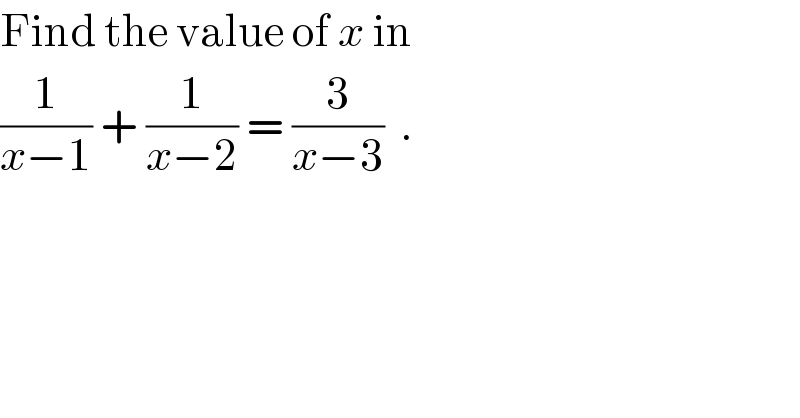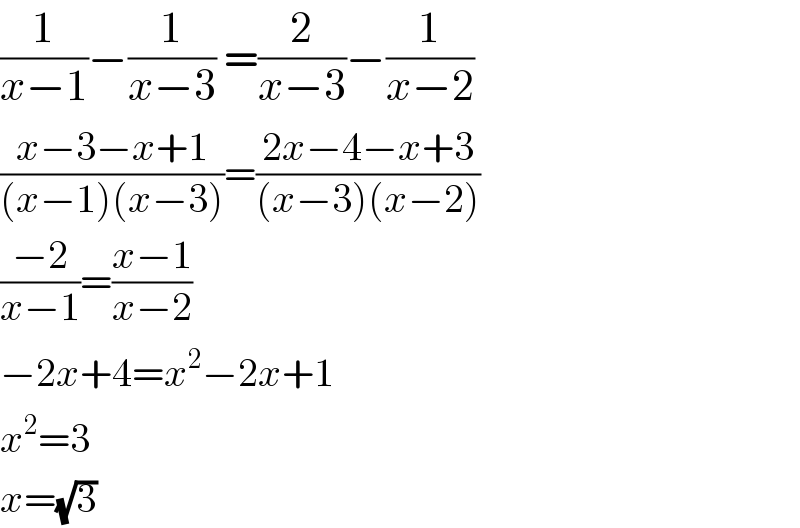
Question Number 62610 by hovea cw last updated on 23/Jun/19

$$\mathrm{Find}\:\mathrm{the}\:\mathrm{value}\:\mathrm{of}\:{x}\:\mathrm{in} \\ $$$$\frac{\mathrm{1}}{{x}−\mathrm{1}}\:+\:\frac{\mathrm{1}}{{x}−\mathrm{2}}\:=\:\frac{\mathrm{3}}{{x}−\mathrm{3}}\:\:. \\ $$
Commented by mathmax by abdo last updated on 24/Jun/19

$${the}\:{set}\:{of}\:{definition}\:{for}\:{this}\:\left({e}\right)\:{is}\:{D}\:={R}−\left\{\mathrm{1},\mathrm{2},\mathrm{3}\right\} \\ $$$$\left({e}\right)\:\Leftrightarrow\frac{{x}−\mathrm{2}+{x}−\mathrm{1}}{\left({x}−\mathrm{1}\right)\left({x}−\mathrm{2}\right)}\:=\frac{\mathrm{3}}{{x}−\mathrm{3}}\:\Rightarrow\frac{\mathrm{2}{x}−\mathrm{3}}{{x}^{\mathrm{2}} −\mathrm{3}{x}+\mathrm{2}}\:=\frac{\mathrm{3}}{{x}−\mathrm{3}}\:\Rightarrow \\ $$$$\left(\mathrm{2}{x}−\mathrm{3}\right)\left({x}−\mathrm{3}\right)\:=\mathrm{3}\left({x}^{\mathrm{2}} −\mathrm{3}{x}+\mathrm{2}\right)\:\Rightarrow\mathrm{2}{x}^{\mathrm{2}} −\mathrm{6}{x}−\mathrm{3}{x}\:+\mathrm{9}\:=\mathrm{3}{x}^{\mathrm{2}} −\mathrm{9}{x}\:+\mathrm{6}\:\Rightarrow \\ $$$$\mathrm{3}{x}^{\mathrm{2}} −\mathrm{9}{x}+\mathrm{6}−\mathrm{2}{x}^{\mathrm{2}} \:+\mathrm{6}{x}−\mathrm{9}\:=\mathrm{0}\:\Rightarrow{x}^{\mathrm{2}} −\mathrm{3}{x}\:−\mathrm{3}\:=\mathrm{0} \\ $$$$\Delta\:=\mathrm{9}−\mathrm{4}\left(−\mathrm{3}\right)\:=\mathrm{9}\:+\mathrm{12}\:=\mathrm{21}\:\Rightarrow{x}_{\mathrm{1}} =\frac{\mathrm{3}+\sqrt{\mathrm{21}}}{\mathrm{2}}\:\:{and}\:{x}_{\mathrm{2}} =\frac{\mathrm{3}−\sqrt{\mathrm{21}}}{\mathrm{2}} \\ $$
Commented by $@ty@m last updated on 24/Jun/19

$${Pl}.\:{check}... \\ $$$$\mathrm{3}{x}^{\mathrm{2}} −\mathrm{9}{x}+\mathrm{6}−\mathrm{2}{x}^{\mathrm{2}} \:+\mathrm{6}{x}−\mathrm{9}\:=\mathrm{0} \\ $$$${should}\:{be} \\ $$$$\mathrm{3}{x}^{\mathrm{2}} −\mathrm{9}{x}+\mathrm{6}−\mathrm{2}{x}^{\mathrm{2}} \:+\mathrm{6}{x}+\mathrm{3}{x}−\mathrm{9}\:=\mathrm{0} \\ $$
Answered by $@ty@m last updated on 23/Jun/19

$$\frac{\mathrm{1}}{{x}−\mathrm{1}}−\frac{\mathrm{1}}{{x}−\mathrm{3}}\:=\frac{\mathrm{2}}{{x}−\mathrm{3}}−\frac{\mathrm{1}}{{x}−\mathrm{2}}\: \\ $$$$\frac{{x}−\mathrm{3}−{x}+\mathrm{1}}{\left({x}−\mathrm{1}\right)\left({x}−\mathrm{3}\right)}=\frac{\mathrm{2}{x}−\mathrm{4}−{x}+\mathrm{3}}{\left({x}−\mathrm{3}\right)\left({x}−\mathrm{2}\right)} \\ $$$$\frac{−\mathrm{2}}{{x}−\mathrm{1}}=\frac{{x}−\mathrm{1}}{{x}−\mathrm{2}} \\ $$$$−\mathrm{2}{x}+\mathrm{4}={x}^{\mathrm{2}} −\mathrm{2}{x}+\mathrm{1} \\ $$$${x}^{\mathrm{2}} =\mathrm{3} \\ $$$${x}=\sqrt{\mathrm{3}} \\ $$
Answered by MJS last updated on 23/Jun/19

$${x}\neq\mathrm{1}\wedge{x}\neq\mathrm{2}\wedge{x}\neq\mathrm{3} \\ $$$$\left({x}−\mathrm{2}\right)\left({x}−\mathrm{3}\right)+\left({x}−\mathrm{1}\right)\left({x}−\mathrm{3}\right)=\mathrm{3}\left({x}−\mathrm{1}\right)\left({x}−\mathrm{2}\right) \\ $$$${x}^{\mathrm{2}} =\mathrm{3} \\ $$$$\Rightarrow\:{x}=\pm\sqrt{\mathrm{3}} \\ $$
